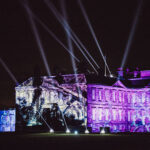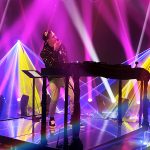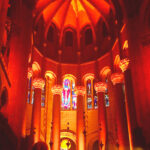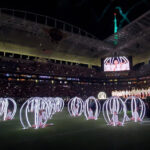Infinity Marketing and Production Design International Team Up for Hewlett-Packard at Coachella and Beyond
Lighting and laser designer Howard Ungerleider was working on a commercial when he got an intriguing call from Kailene Horlitz. Kailene and her company, Los Angeles-based Infinity Marketing, were trying to help Hewlett-Packard promote their new Pavilion line of PCs with HP’s first big foray into a new kind of immersive, interactive experience. The plan was to launch this new experiential marketing concept at Coachella 2017.
“They wanted to do something unusual with lasers, combined with new technology they were developing,” says Ungerleider, a 2014 Parnelli Visionary honoree, the LD for Rush for 40-plus years, and co-owner of Toronto-based Production Design International (PDI).

PDI specializes in lighting and laser work, so after Horlitz reached out to him based on a recommendation from See Factor Industry’s Mark Friedman, Ungerleider jumped in with both feet.
“The conversations started in late winter, and Kailene had a lot of questions about lasers, particularly if they had even been used with an interactive app,” Ungerleider says. “I told her I wasn’t aware of it ever being done, but it does inherently have the capability. I then said we were very interested in exploring the possibilities.”
By the time Coachella returned to the Empire Polo Grounds in Indio, CA for two weekends of music and art in mid-to-late April, a vivid hands-on interactive experience was waiting for festival attendees, inviting them to create their own laser show via a proprietary app set up on each of four new HP Spectre x360 2-in-1 convertible PC laptops in a dome environment.

Envisioning the Possibilities
“Kailene had the basic idea of what she wanted to do — combining lasers with this app — and she explained her interpretation to me,” says Ungerleider, who worked with PDI colleague Scott Wilson on the project. “Scott and I brainstormed until we had a vision of it all,” Ungerleider says.
Wilson, who has been with PDI for a decade, put together a drawing and sent it over to Horlitz and the rest of the Infinity team, and they loved it. From there, the teams at PDI and Infinity tackled a variety of details with a series of conference calls so that visitors to the dome-shaped HP Lounge, adjacent to HP’s bigger Antarctic dome, would be treated to a new kind of high-tech experience. “Infinity had a team of people developing this app, and Scott knows all our laser technology, so they all worked with Pangolin Software to put parameters together,” Ungerleider notes.
Wilson says that the teams he was working with specifically wanted to put into play the Microsoft technology called “inking.” “It’s different gestures and interfaces and allows the computer to recognize users drawing on computer screens with special pens,” he explains. “This controlled the lasers’ movements and created a kaleidoscope environment.
“The initial focus was to be able to draw something on the screen and have it suddenly brought to life above your head, with the user completely controlling the lasers movement focus,” Wilson adds. “Then we came up with the idea of doing curated atmospheric effects that could be manipulated via sliders and dials [on the Spectre], scrolling through pre-determined layer effects and color separation. The app, called LightInk, is really a bridge between the technology and our laser software, and with the network communication protocol from Pangolin, it just all really came together well.”

Three Minutes of Glory
While HP’s bigger Antarctic dome at Coachella measured close to 120 feet in diameter and featured a 500-seat theater for large format video projections, the Spectre-controlled laser show was featured in the smaller 44-foot dome-shaped HP Lounge area. There, visitors could also use HP products to design and print their own bandanas, or try on a helmet that would take them into a virtual world and let them take pictures of their 360-degree experience there. But a key attraction to the HP Lounge were the four Spectre laptops that let people control eight Kvant Spectrum and RTI PIKO Cube 11 laser systems, making any casual visitor feel like a rock star laser show designer.
“We like how the graphics are sharp and clear in the PIKO systems when coupled with the Kvant lasers for the full color and power that their products offer,” Ungerleider says. “We were able to put at the user’s disposal some avant garde effects by adding in scanners focused on mirrors. It was all supported by the app and the Pangolin software.”
Wilson adds that the compact laser setup was bright and powerful within the compact dome, and that the pen software was impressive to users as well. “It controls any aspect of the software controlling the lasers,” he says. “The user can start with the more basic shapes in animation but have the ability to create complex laser effects, and they really aren’t limited in any way that would stifle their creativity.”
From the HP Lounge dome’s entrance to the exit, people snaked through the space to the beat of a DJ, with the interactive lasers shooting overhead. Each station let users take control for three minutes. A timer showed how long they had to wait to gain access, and how much time they had to create their own laser show.
Safety was a key concern, of course — something Ungerleider has been dealing with practically every day in his years of working with lasers.

“We are licensed in all the states and understand all the variances from one to another, and we abide by all the rules and regulations,” he says. “We’re one of the premier companies and know how to work with the laser safety engineers. We know how to obtain approval for whatever we’re doing — for example, if we do any work outside, we have to file with the FAA and get advance clearance from them.”
Alban Sardinski of See Factor supplied the additional lighting in the dome, placing Robe LED Pars and Kinetic light fixtures in a 360-degree array to complement the laser looks. See Factor also supplied the sound.
After wowing the Coachella crowds for the festival’s two weekends in April, HP brought its interactive laser dome idea to a large dome set up for the Panorama Music Festival, which took place at Randall’s Island Park in New York City July 28-30. (Ungerleider notes that the design teams got the chance to optimize the laser shows for the space and add a few tweaks to the overall experience.)
But the basic concept — to impress audiences with the laser visuals that they, themselves, appear to create — is new, and, most likely, here to stay. “From the moment people stepped into the dome, they are having interactive experiences, and it was so cool to see their faces light up as they started to operate the lasers,” Wilson says. “It was great, exciting experience.”



